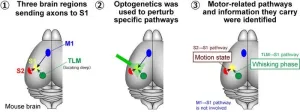(Press-News.org) WASHINGTON—Endocrine-disrupting chemicals (EDCs) in plastics pose a serious threat to public health and cost the U.S. an estimated $250 billion in increased health care costs in 2018, according to new research published in the Journal of the Endocrine Society.
Plastics contain many hazardous, endocrine-disrupting chemicals that leach and contaminate humans and the environment. These chemicals disturb the body’s hormone systems and can cause cancer, diabetes, reproductive disorders, neurological impairments of developing fetuses and children, and death.
Potential options under discussion as part of a Global Plastics Treaty include interventions to reduce EDC exposure to protect public health and the environment, and data on the health costs of EDCs could help move this initiative forward.
“Our study found plastics contribute substantially to disease and associated social costs in the U.S., about $250 billion in 2018 alone. These costs are equivalent to 1.22% of the Gross Domestic Product. The diseases due to plastics run the entire life course from preterm birth to obesity, heart disease and cancers,” said study author Leonardo Trasande, M.D., M.P.P., of NYU Grossman School of Medicine and NYU Wagner Graduate School of Public Service in New York, N.Y. Trasande has represented the Society at intergovernmental meetings to address plastic pollution and its health effects.
“Our study drives home the need to address chemicals used in plastic materials as part of the Global Plastics Treaty,” Trasande said. “Actions through the Global Plastics Treaty and other policy initiatives will reduce these costs in proportion to the actual reductions in chemical exposures achieved.”
The researchers analyzed existing studies on EDCs to identify how many diseases and disabilities were attributed to chemicals in plastics. The chemicals they studied commonly found in plastics included polybrominated diphenyl ethers (PBDE), phthalates, bisphenols, and poly- and perfluoroalkyl substances (PFAS).
The researchers updated previously published data on disease burden and cost estimates for these chemicals in the United States to 2018. They combined the data and estimated $250 billion in disease burden from plastic exposure in 2018.
"This study shows that preventing plastic pollution can reduce the incidence of disease, disability and early death, and its attendant human suffering and health care costs,” said co-author Michael Belliveau, Executive Director of Defend Our Health based in Portland, Maine. “Policymakers and market leaders must detoxify and slash the use of petrochemical plastics and endocrine-disrupting chemicals. We urge negotiators to finalize a Global Plastics Treaty that caps and reduces plastic production and eliminate EDCs as plastics additives.”
Most of the cost burden was from polybrominated diphenyl ethers (PBDE) exposure which is associated with diseases such as cancer. Sixty-seven billion in health costs was due to phthalate exposure which is linked to preterm birth, reduced sperm count and childhood obesity, and $22 billion was due to PFAS exposure which is associated with kidney failure and gestational diabetes.
The other authors of this study are Roopa Krithivasan of Defend Our Health; Kevin Park of NYU Grossman School of Medicine; and Vladislav Obsekov of Children’s Hospital of Philadelphia in Philadelphia, Pa.
The study was funded by the National Institutes of Health’s National Institute of Environmental Health Sciences and The Passport Foundation.
The manuscript, “Chemicals Used in Plastic Materials: An Estimate of the Attributable Disease Burden and Costs in the US,” was published online.
# # #
Endocrinologists are at the core of solving the most pressing health problems of our time, from diabetes and obesity to infertility, bone health, and hormone-related cancers. The Endocrine Society is the world’s oldest and largest organization of scientists devoted to hormone research and physicians who care for people with hormone-related conditions.
The Society has more than 18,000 members, including scientists, physicians, educators, nurses and students in 122 countries. To learn more about the Society and the field of endocrinology, visit our site at www.endocrine.org. Follow us on Twitter at @TheEndoSociety and @EndoMedia.
END
U.S. health costs related to chemicals in plastics reached $250 billion in 2018
Harmful chemicals in plastics contribute to cancer, diabetes, other endocrine diseases
2024-01-11
ELSE PRESS RELEASES FROM THIS DATE:
Experiments in infant mice suggest new way to prevent spread of flu in people
2024-01-11
Scientists have long known that some viruses and bacteria begin infections by latching first onto sugar molecules on the surfaces of cells lining the sinuses and throat of mammals, including humans. Viral particles, for instance, can attach to these molecules, called sialic acids, or SAs, like keys fitting into locks.
Now, a new study in infant mice shows that keeping virus particles from attaching to SAs limits more than just the entry of influenza A viral infections, but also hinders their exit (shedding) and transmission from mouse to mouse. Such infections are the main cause of the seasonal flu that kills more than 36,000 Americans annually. While vaccines to guard ...
A universal coronavirus vaccine could save billions of dollars if ready before next pandemic
2024-01-11
What if scientists had developed a universal coronavirus vaccine in the years prior to 2020 so that it was available at the start of the COVID-19 pandemic? A universal coronavirus vaccine targets parts of the virus that are common to either many or all coronaviruses, thereby offering some degree of protection against a range of strains. A new study suggests if such a vaccine were available at the start of the pandemic, it could have saved millions of lives, prevented suffering, and saved billions of dollars in direct medical ...
Virtual Science Writers Conference will uncover the truth behind ‘hormone balancing’
2024-01-11
WASHINGTON—The popular TikTok trend of ‘hormone balancing’ has taken over the internet with claims to balance your hormones with holistic approaches alone, but medical experts question its legitimacy.
Endocrine Society expert Deena Adimoolam, M.D., will discuss ‘hormone balancing’ during the Society’s Virtual Science Writers Conference on January 24.
What: The Virtual Science Writers Conference will examine:
How hormones function and stay in balance
Common ...
Toxic algae blooms: Study assesses potential health hazards to humans
2024-01-11
Florida’s 156-mile-long Indian River Lagoon (IRL) borders five different counties and has five inlets that connect the lagoon with the Atlantic Ocean. In recent years, this estuary has experienced numerous phytoplankton bloom events due to increased seasonal temperatures coupled with environmental impacts.
Algal blooms produce a myriad of small organic molecules, many of which can be toxic to humans and animals. Among these phycotoxin producers is Microcystis aeruginosa, a freshwater cyanobacterium, which can be found in the Southern IRL. Measurable amounts of microcystins have been found in nasal swabs ...
Researchers discover potential microbiome links to skin aging
2024-01-11
The effects of aging and external factors like UV exposure on skin are well documented. As people age or spend more time in the sun, their skin tends to become drier and more wrinkled,
Recent findings have identified an exciting potential new link to signs of skin aging—the skin microbiome, the collection of microorganisms that inhabits our skin. The results come from a collaborative study carried out by researchers at the Center for Microbiome Innovation (CMI) at the University of California San Diego (UC San Diego) and L'Oréal ...
Join us in sunny San Diego for the ATS 2024 International Conference May 19-22
2024-01-11
What’s New: Register now to learn about the latest in pulmonary, critical care and sleep medicine. Join us for scientific sessions and expert interviews. Thirteen sessions will be livestreamed.
Why it matters: Stay up-to-date on subjects like COVID-19, asthma, COPD, and air pollution. We’ll assist you with conducting interviews, whether in-person or from your home office.
Contact Kevin Tuerff, ATS Communications & Marketing for more information, at ktuerff@thoracic.org END ...
Chemical Insights Research Institute commits to public health research with the opening of new laboratories
2024-01-11
ATLANTA – Chemical Insights Research Institute (CIRI) of UL Research Institutes confirmed its commitment to protecting environmental and human health when it opened its new research laboratories supporting scientific studies of environmental exposure and its societal health impact. At a ribbon cutting today, CIRI introduced the Center for Exposure Science; the Center for Toxicology and Human Health; and the Center for Advanced Measurements, each with a designated, cutting-edge laboratory.
Using the latest tools for measuring nanosized particles and parts per billion levels of chemicals and developing high-throughput cellular techniques for measuring human toxicity, ...
Challenging the traditional views on how the brain processes movement and sensation
2024-01-11
The brain is widely considered the most complex organ in the human body. The intricate mechanisms through which it processes sensory information and how this information affects and is affected by motor control have captivated neuroscientists for more than a century. Today, thanks to advanced laboratory tools and techniques, researchers can use animal models to solve this puzzle, especially in the mouse brain.
During the 20th century, experiments with anesthetized mice proved that sensory inputs primarily define neuronal activity in the primary ...
Understanding healthy and happy expectancy in former soviet countries
2024-01-11
The dissolution of the Soviet Union in 1991 marked the start of a period ripe with political, economic, and societal changes. In many former Soviet countries, these abrupt and turbulent transformations posed massive challenges to healthcare systems. Together with spikes in job losses and economic hardships, this led to a steep increase in mortality rates that would later come to be known as the “post-Soviet mortality crisis.”
However, this crisis did not affect all former Soviet countries equally. In particular, former Soviet countries in Central Asia, which include Kazakhstan, Kyrgyzstan, Tajikistan, Turkmenistan, and Uzbekistan, saw a ...
Revolutionizing real-time data processing with edge computing and reservoir technology
2024-01-11
Every day, a significant amount of data related to weather, traffic, and social media undergo real-time processing. In traditional cloud computing, this processing occurs on the cloud, raising concerns about issues such as leaks, communication delays, slow speeds, and higher power consumption. Against this backdrop, “edge computing” presents a promising alternative solution. Located near users, it aims to distribute computations, thereby reducing the load and speeding up data processing. Specifically, edge AI, which involves AI processing at the edge, is expected to find applications in, for example, self-driving ...
LAST 30 PRESS RELEASES:
Numbers in our sights affect how we perceive space
SIMJ announces global collaborative book project in commemoration of its 75th anniversary
Air pollution exposure and birth weight
Obstructive sleep apnea risk and mental health conditions among older adults
How talking slows eye movements behind the wheel
The Ceramic Society of Japan’s Oxoate Ceramics Research Association launches new international book project
Heart-brain connection: international study reveals the role of the vagus nerve in keeping the heart young
Researchers identify Rb1 as a predictive biomarker for a new therapeutic strategy in some breast cancers
Survey reveals ethical gaps slowing AI adoption in pediatric surgery
Stimulant ADHD medications work differently than thought
AI overestimates how smart people are, according to HSE economists
HSE researchers create genome-wide map of quadruplexes
Scientists boost cell "powerhouses" to burn more calories
Automatic label checking: The missing step in making reliable medical AI
Low daily alcohol intake linked to 50% heightened mouth cancer risk in India
American Meteorological Society announces Rick Spinrad as 2026 President-Elect
Biomass-based carbon capture spotlighted in newly released global climate webinar recording
Illuminating invisible nano pollutants: advanced bioimaging tracks the full journey of emerging nanoscale contaminants in living systems
How does age affect recovery from spinal cord injury?
Novel AI tool offers prognosis for patients with head and neck cancer
Fathers’ microplastic exposure tied to their children’s metabolic problems
Research validates laboratory model for studying high-grade serous ovarian cancer
SIR 2026 delivers transformative breakthroughs in minimally invasive medicine to improve patient care
Stem Cell Reports most downloaded papers of 2025 highlight the breadth and impact of stem cell research
Oxford-led study estimates NHS spends around 3% of its primary and secondary care budget on the health impacts of heat and cold in England
A researcher’s long quest leads to a smart composite breakthrough
Urban wild bees act as “microbial sensors” of city health.
New study finds where you live affects recovery after a hip fracture
Forecasting the impact of fully automated vehicle adoption on US road traffic injuries
Alcohol-related hospitalizations from 2016 to 2022
[Press-News.org] U.S. health costs related to chemicals in plastics reached $250 billion in 2018Harmful chemicals in plastics contribute to cancer, diabetes, other endocrine diseases




